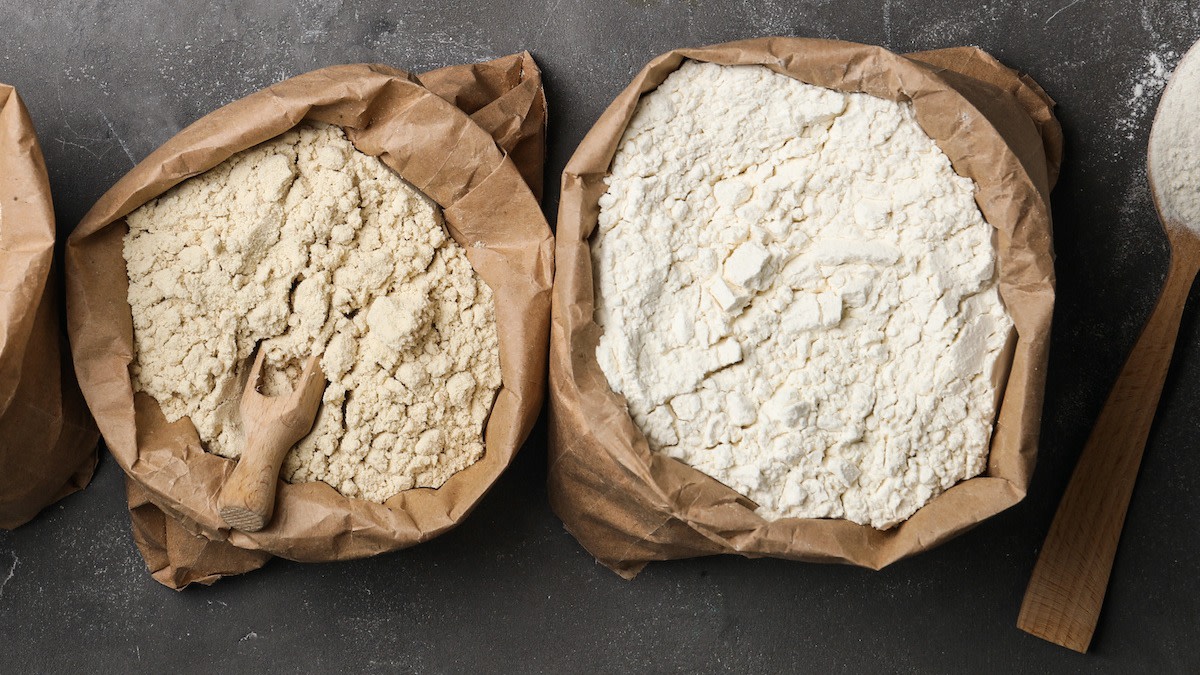Cake Flour vs. Bread Flour: What’s the Difference?
Written by MasterClass
Last updated: Jun 7, 2021 • 3 min read
Not all white flour is the same. Learn about two specialty wheat flours and when to use each in baking.
Learn From the Best
What Is Flour?
Flour is the powdery result of grinding wheat, corn, rice, or seeds (or dried roots like cassava). It’s useful in many different culinary applications, from baked goods like breads, cakes, and pie crusts to roux for sauces and airy batters. Most conventional flours are made from wheat kernels (or wheat berries), which consist of an endosperm, a germ, and a bran.
What Is Cake Flour?
For spongy, light-as-air cakes, you have cake flour. Made from a soft wheat and ground to a fine texture, cake flour has a low protein content (and thus, less gluten) than all-purpose flour, which results in a lighter, loosely-structured crumb.
How to Use Cake Flour in Baking
Cake flour is useful for baked goods with a tender texture, such as brownies, layer cakes, cupcakes, scones, and quick breads. You can also use cake flour to make pastries or desserts that are light and fluffy. For heartier baked goods, skip the cake flour and use a more substantial type of flour with a higher protein content.
What Is Bread Flour?
Bread flour is a type of wheat flour with a particularly high gluten protein content—up to about 12 percent. This high protein content translates to high gluten content, which makes for a more open crumb. When yeast ferments during the early stages of baking bread, carbon dioxide gets trapped by the protein-bonded flour, resulting in stretchy dough with air pockets in the crumb.
How to Use Bread Flour in Baking
Bread flour is most popular for baking breads, since its high-protein flour is packed with gluten, and gluten creates the elasticity that bread needs to rise. You can use bread flour to make bread, pizza dough, and cinnamon rolls.
Cake Flour, Bread Flour, and All-Purpose Flour: How Are They Different?
Bread flour is a type of hard wheat flour with high protein (up to 12 percent) relative to starch. A higher protein content means more gluten formation and stronger breads. Soft wheat, often labeled “cake flour” (six percent protein) or “pastry flour” (seven to nine percent protein), includes less gluten, yielding a more delicate result. The ubiquitous all-purpose flour? It’s a blend of both—though it tends to be on the harder side, at least in the U.S., with around 10 percent protein.
Why Flour Protein Content Matters
Protein content in flour is influenced by both the type of wheat grain and whether or not the flour has been enriched. The amount of protein then determines how much gluten can develop in the flour when kneaded and baked. Hard wheat, for example, has a protein content range of 10 to 13 percent and produces bagels and chewy breads with crackling crusts. Softer strains of wheat flours with six to seven percent protein content are best for cakes and cookies. Additives like ascorbic acid and potassium bromate are sometimes added to flours to enhance gluten development.
Easy Flour Substitution Guide
Although it's always ideal to follow the recipe, you can substitute flours in a pinch.
- 1. Substitute all-purpose flour for cake flour. To mimic the effects of cake flour with AP flour, remove two tablespoons of flour and replace it with two tablespoons of cornstarch, which will prevent the formation of gluten to similar effect.
- 2. Substitute cake flour for all-purpose flour. If a recipe calls for all-purpose flour, you can achieve a more tender end result by substituting an equal amount of cake flour.
- 3. Substitute all-purpose flour for bread flour. All-purpose flour and bread flour are similar enough in protein content that you can substitute AP flour for bread flour one-to-one. Increase the protein level of all-purpose flour by adding a tablespoon or two of vital wheat gluten. Without the gluten, breads may rise slightly less, and they may have a less chewy texture.
- 4. Substitute bread flour for all-purpose flour. You can substitute bread flour for AP flour one-to-one in bread recipes. For other recipes, using bread flour will likely result in a chewier texture. Your dough might end up slightly drier, so add a little water if needed.
Bready for More?
We’ve got you covered. All you knead (see what we did there?) is The MasterClass Annual Membership, some water, flour, salt, and yeast, and our exclusive lessons from Apollonia Poilâne—Paris’s premier bread maker and one of the earliest architects of the artisanal bread movement. Roll up your sleeves and get baking.
